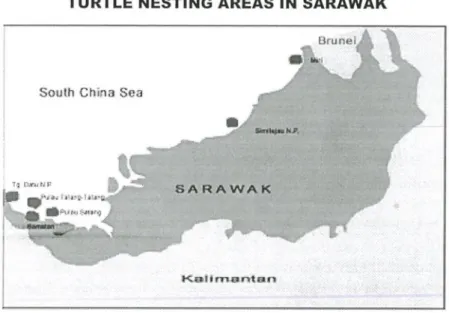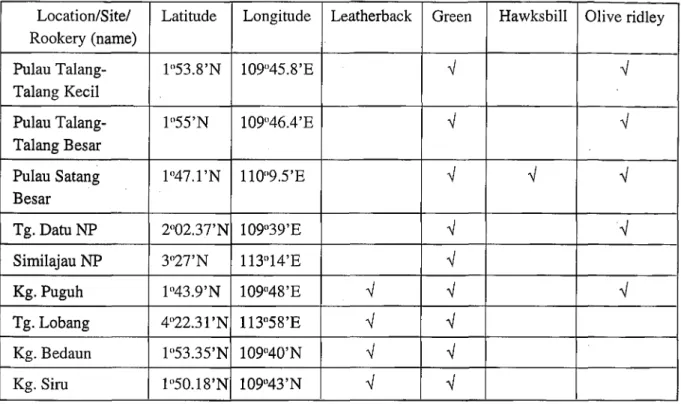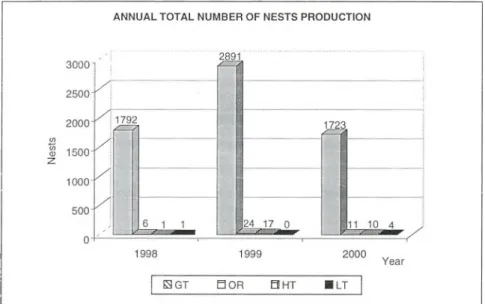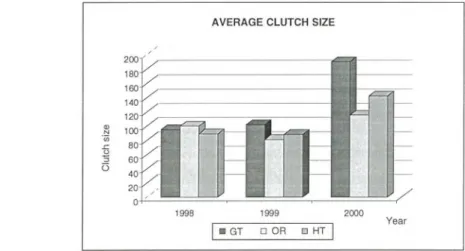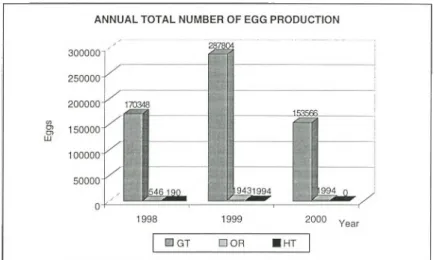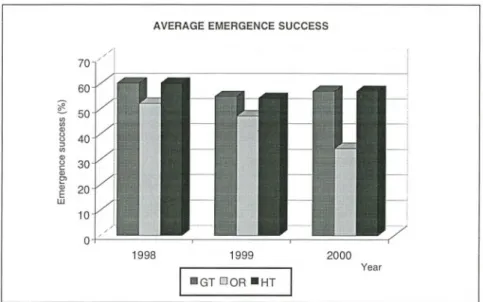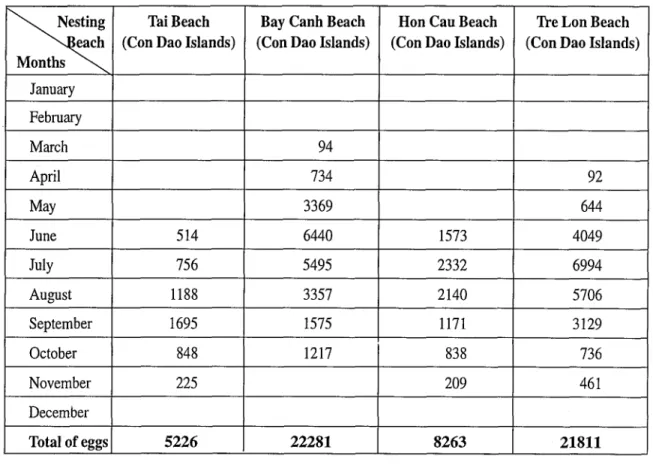He briefly informed the meeting about the sea turtle population statistics and nesting sites in Myanmar. In this country, five species of sea turtles were found (green turtle, loggerhead, olive ridley, loggerhead and leatherback).

DISCUSSION ON SEA TURTLE STATISTICS
The meeting was informed of the lack of up-to-date information on sea turtle habitat, population statistics and nesting locations at Cam Bodia due to a lack of budget to carry out the study. Long species of sea turtles (green, loggerhead, olive, loggerhead and leatherback) have been recorded in this country.
Statistical data for the year 2000 must be submitted by all member countries to the M FR D M D before the end of March 2001 for compilation and publication. viii). All member countries are requested to report to M FR D M D for any updated or updated information.
DISCUSSION ON THE SEA TURTLE TAGGING PROGRAM 18. The participants discussed and agreed on the follow ing issues
It is calculated using the following for. Drafts of this document will be circulated to Member States for their comments prior to publication. vii). Member States are encouraged to analyze statistical and turtle tagging data using appropriate software for better results and data interpretation.
RESOLUTIONS
DEPARTMENT OF DEVELOPMENT AND MANAGEMENT OF MARINE FISHERIES RESOURCES (MFRDMD). v) M FR D M D is requested to collate and collate all sea turtle tagging data from the region and, with the help of experts to be determined later by M FR D M D, convene a rained workshop for this purpose . o f analyzing available sea turtle tagging data prior to 2003. vi) The meeting acknowledged the need for the SEA FD E C to continue its financial support to member countries in the sea turtle tagging program. vii) Agreed meeting on sea turtle tagging methodology to be expanded to include other technologies. points such as the use of satellite tracking. viii). It is hoped that the sea turtle population statistics and tagging program will be continuously conducted in the future for better sea turtle management in the region.
ANNEX 1
THE FIRST SEAFDEC MEETING ON
Training course in sea turtle conservation and management for new members of SEA FD E C (Indonesia, Cambodia, M yanmar and Vietnam.
REVIEW ON THE PROGRESS OF
REGIONAL SEA TURTLES TAGGING PROGRAM AND POPULATION STATISTICS
INTRODUCTION
Finally, this information will facilitate MFRDMD/SEAFDEC to prepare a bulletin on sea turtle population statistics in Southeast Asia and to create a digitized atlas of sea turtles in the region. The following table showed the distribution of six species of sea turtles in the SEAFDEC member countries.
REGIONAL SEA TURTLE POPULATION STATISTICS
MFRDMD as host had submitted two proposals (i) Cooperative Sea Turtle Tagging Program in the Southeast Asia Region and (ii) Sea Turtle Statistics for Southeast Asia. The First SEAFDEC Meeting on Regional Data Management of Sea Turtles was organized by MFRDMD / SEAFDEC with the aim of assessing the progress of the action taken by the SEAFDEC Members' Council.
REGIONAL SEA TURTLE TAGGING PROGRAM
Paper presented at the First SEAFDEC - ASEAN Regional Workshop on Sea Turtle Conservation and Management, Kuala Terengganu, Malaysia, 26 - 28 July 1999. Paper presented at the First SEAFDEC - ASEAN Regional Workshop on Sea Turtle Conservation and Management Kuala Terengganu, Malaysia, 26 - 28 July 1999.
SUMMARY REPORT OF
SEA TURTLE POPULATION STATISTICS IN EAST COAST OF PENINSULAR MALAYSIA
- SPECIES OCCURRENCE
- HATCHERY
- ANNUAL LANDING Leatherback: 19
- ANNUAL NESTING Leatherback: 19
- PEAK SEASON
- TOTAL OF EGGS INCUBATED Leatherback: 1,385
- TOTAL OF HATCHLINGS
- MORTALITY Leatherback: 2
- ANNUAL LANDING Leatherback: 10
- TOTAL OF EGGS INCUBATED Leatherback: 586
- TOTAL HATCHLINGS
- ANNUAL LANDING Leatherback: 28
- TOTAL OF EGGS INCUBATED Leatherback: 1,809
- TOTAL OF EGGS INCUBATED
- TOTAL OF MORTALITY No record
- TOTAL OF EGGS INCUBATED Green: 23,622
- TOTAL OF EGGS INCUBATED Green: 10,681
These species are Leatherback (Dermochelys coriacea), Green (Chelonia mydas), Hawksbill (Eretmochelys imbricata) and Olive Ridley (Lepidochelys olivacea).
TURTLE ISLANDS PARK, SABAH, MALAYSIA
POPULATION STATISTICS OF SEA TURTLES1
- ANNUAL LANDING AND NESTING 1 Green Turtle
- Hawksbill Turtle
- GREEN AND HAWKSBILL TURTLE: ANNUAL EGG PRODUCTION, INCUBATION AND HATCHLING
- Year 1998
- Year 1999
- Year 2000
- TURTLE MORTALITY
- HIGH TIDE
- CONCLUSIONS
Other high monthly landings were also observed during July at Selingaan and Bakkungaan Kechil with 363 and 279 landings respectively. For the year 1999, Selingaan again recorded the highest monthly landing of 863, which occurred in May. For the year 1998, Gulisaan recorded the highest monthly hawksbill landings in July with 47 landings.
For 2000, the highest monthly landings in Gulisaan occurred in January, February and March with 33 landings each. For Selingaan, the highest monthly reductions were in March with 8 reductions, while for Bakkungaan Kechil it was in February with 5 reductions.
COUNTRY REPORT
MALAYSIA
Introduction
For more than 150 years, eggs laid by Sarawak's sea turtles have been harvested by humans for consumption. Since 1927 this harvest has been particularly efficient, and most of the eggs laid have been collected (Hendrickson, 1957 in Harrison, 1962). The Sarawak Museum has been recording the annual green turtle landing of green turtles on each of the Turtle Islands (Pulau Talang-Talang Besar, Pulau Talang-Talang Kecil and Pulau Satang Besar) since 1946.
Turtles Trust Ordinance 1957, Sarawak Wildlife Protection Ordinance 1957, Sarawak Protection Ordinance 1973, Wildlife Protection Ordinance 1990 (amended 1995, and Sarawak Wildlife Ordinance 1998 Wildlife were promulgated to conserve, protect and manage the turtles in Sarawak. have been put forward for the declination, such as : overharvest of eggs, accidental mortality in fishing gear.
SEA TURTLES MANAGEMENT AND CONSERVATION IN SARAWAK
The Director of the Museum still remained the Executive Officer of the Turtle Board, but his jurisdiction now extended only to the three Turtle Islands. Under the Fisheries (Prohibited Areas) Regulations 1994, marine waters within two nautical miles of the outermost points of the Sarawak Turtle Islands (measured from low water mark) of: Pulau Talang-Talang Besar; Pulau Talang-Talang Kecil; and Pulau Satang Besar) are Prohibited Fishing Areas under section 61 of the Fisheries Act 1985. This project has also enabled various agencies to co-ordinate a responsible and coordinated research program for the Sarawak Turtle Islands.
It also makes management recommendations where appropriate which are then forwarded to the Turtle's Board for consideration. In addition, the group has also been able to oversee the enforcement of various rules and regulations for sea turtles on the Turtle Islands.
NESTING SITES
SPECIES OCCURRENCE
NUMBER OF NESTS
Three more nests were found in Kampung Siru and Kampung Bedaun in Sematan, but all the eggs were collected by villagers. Figure 2 shows the number of nests for each turtle species recorded in Sarawak from 1998 to 2000.
NUMBER OF EGG
CLUTCH SIZE
EMERGENCE SUCCESS
CONCLUSION
In the year 1978, three species of sea turtles in Indonesia were protected, and in the year 1999, all sea turtles (6 species) have been protected based on the regulation of government no. The six species of sea turtles are Dermochelys coriacea, Eretmochelys imbricata, Chelonia mydas, Lepidochelys olivacea, Natator depressus and Caretta caretta. According to all sea turtles, including migratory species, and they have differences in migratory behavior, conservation efforts must be strengthened.
MARINE RESOURCES MANAGEMENT AND ITS IMPLEMENTATION IN INDONESIA The main objective of the National Sea Turtle Conservation Strategy:.
MANAGEMENT OF SEA TURTLES AND ITS IMPLEMENTATION IN INDONESIA The main objective of national sea turtle conservation strategy
TAGGING PROGRAM
MONITORING POPULATION STATISTIC
Monitoring at the research station in several national parks (Alas Purwo National Park, Mem Betiri National Park, Kepulauan Seribu National Park) and in the working area by our competent regional office (BKSDA) in West Java Province, Irian Jaya Province, East Borneo Province and other cities.
Tin Win
To obtain biological information about sea turtles, sea turtle tagging exercises were practiced in many countries. Although Myanmar has some of the largest nesting sites for sea turtles, tagging exercises have not yet been introduced in the country due to some issues. In support of informed and wise management of sea turtles living in its national parks, Myanmar's Ministry of Fisheries recently conducted an assessment of the status of the country's sea turtle population.
The Ministry of Fisheries has started establishing a sea turtle conservation and research program in Thamihla Kyun (Diamond Island) since 1986. Shrimp fishing has been identified as one of the leading causes of sea turtle mortality worldwide. Although Myanmar has many islands and sandbanks in its coastal areas where sea turtles can nest, the Ministry of Fisheries can currently only implement a sea turtle conservation program in the Ayeyarwady Delta areas.
Since sea turtles are recognized as one of the most critically endangered species in the world, the Ministry of Fisheries also plans to establish a new unit for sea turtle conservation and management within its organization.
REPORT ON SEA TURTLES STATISTIC IN CAMBODIA
Box 582, Phnom Penh, Cambodia (Paper for meeting on local sea turtle data management, Kuala Terengganu, Malaysia, November 20-22, 2000). Managing and conserving living marine resources is the main responsibility of the Department of Fisheries. So far, the Department of Fisheries does not have information on sea turtle habitats, population statistics and nesting sites.
Previous studies report that five species of sea turtles have been found on the Cambodian coast: Olive Ridley Turtle (Lepidochelys olivacea), Hawksbill Turtle (Eretmochelys imbricata), Hawksbill Turtle (Caretta caretta), Green Turtle (Chelonia mydas) and Leatherback Turtle (Dermochelys coriacea). ) (Try, 1999). So far, the Ministry of Fisheries does not have information and statistics on the sea turtle population, nesting opportunities and the number of turtles caught by fishermen because, even if caught accidentally, they try to hide it from the fisheries authorities.
STATUS ON MARINE TURTLE STUDY AND CONSERVATION IN VIETNAM SEA WATER
- VIETNAM RESEARCHER ON MARINE TURTLE
- SOME RESULTS OF MARINE TURTLE STUDY IN VIETNAM SEA WATER 1. Species composition and distribution
- Nesting season and breeding grounds
- THE SEA TURTLE STATUS IN VIETNAM
- CONSERVATION AND MANAGEMENT IN VIETNAM
- REFERENCES
According to research and statistical results, there are 5 species of sea turtles belonging to 2 families, 3 genera. At present, we have not yet identified the breeding bases of sea turtles in northern and central Vietnam. From the 1980s and back, the source of sea turtles in Vietnam was abundant not only in species composition.
Breeding areas were destroyed by tourism activities, egg collection and the capture of sea turtle mothers. Sea turtle species in Vietnam were recorded in the Red Book of Vietnam, the Vietnamese government.
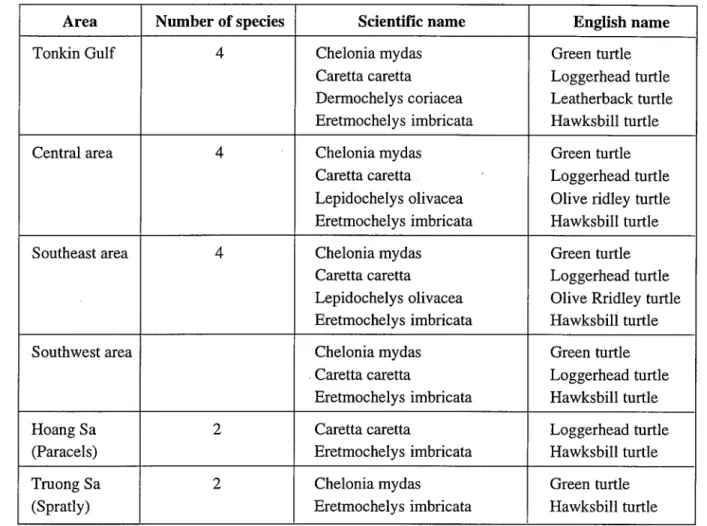
APPENDIX
- PROGRESS ON TAGGING EXERCISE 1 Tagging Period and Tagging Method
- Number of Turtle Tagged
- Tags Return
- Tag Loss
- Dead Turtle with Inconel Tags
- SUBSEQUENT STEPS TAKEN BY SABAH PARKS
- CONCLUSIONS
- ACKNOWLEDGMENTS
Under this project, sea turtles will be externally tagged on both of their front wheels using inconel tags. These inconel tags were applied to landing or nesting sea turtles beginning July 8, 1999, through September 4, 1999. Sea turtles were tagged twice, with each tag applied through the first large axillary scale at the trailing edge of the two front flips.
Thirty-two tags were missing from turtles returning for the first time, while eight tags and three tags were missing during their second and third returns, respectively. Implementation of this regional tagging program, to double tag sea turtles with inconel tags, could undoubtedly provide accurate information on the reproductive biology and population trends and dynamics of sea turtles.
